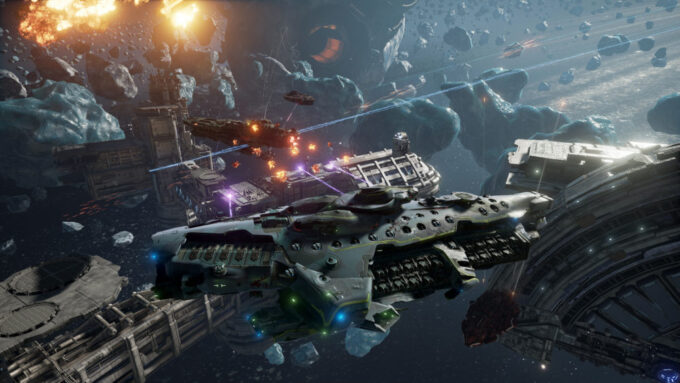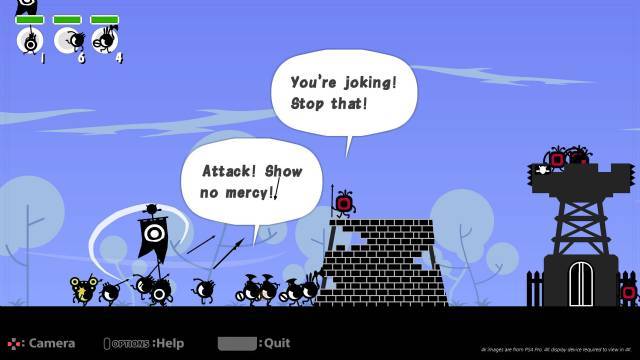Dreadnought, the combat flight simulator from Yager Development, introduces a novel take on the adversarial deathmatch and team deathmatch formula that has long been co-opted by a whole host of other efforts. Dreadnought offers a fresh approach by locking players into hulking great spaceships and forcing them to deal with the invariably slower pace and awkward gait that go along with it. Essentially, imagine if the space combat portions of Star Wars Battlefront only let you control Star Destroyers and you start to get the idea.
A different sort of deathmatch battler
Viewed from a third person perspective, you can elect to take on a team of AI ships by yourself in free-for-all combat, or, employ a group of actual humans to form a team (or Fleet, as it’s called here) and go off fighting either AI opponents or other human opponents. The goal, naturally, is to obliterate the other team by scoring as many kills as possible before the time limit elapses. Given the expansive size of your craft however, there’s a little more to it than just putting yourself in the direction of your enemy and hammering the ‘fire’ button until your foes keel over and explode.
The first thing you’ll notice is how your arsenal of weapons is managed. Rather than all your bang-bang being fired from what would essentially be the nose of the ship, the lengthy dimensions of your Dreadnought allows you to shoot from an array of broadside cannons in addition to a collection of missile and rocket batteries that are dotted along the side of the ship. As such, the relatively unusual placement of these armaments means that positioning of your ship during battle is absolutely key; a close-quarters shootout with another similarly sized ship will, for example, go much better for you if your own Dreadnought is positioned to be able to bring its vast array of broadside-based firepower to bear.
Another obvious quirk that requires mastery is the handling of the Dreadnoughts themselves. Being as they are massive, unwieldy metal beasts that feel more like flying tanks than dexterous attack craft, wide turning circles and sluggish speeds soon become the norm and do, inevitably, take some getting used to. The much more leisurely pace also changes how you approach combat too, asking that the player forfeit split-second reactions in favour of planning, strategizing and measuring distances before attacking the enemy.
Guns, missiles and rockets aren’t your only path to success however; as each Dreadnought can be kitted out with a variety of defensive and evasion gadgetry to get you out of a tight jam should the occasion call for it. Such systems range from the simple to the complex, including such neat toys as a short-range warp drive that effectively teleports you out of danger, a healing laser that regenerates friendly ships and an anti-missile battery allows your Dreadnought to destroy incoming projectiles before they hit home. What all of them have in common though, and this is something which also applies to your primary weapons systems, is that they operate on a cooldown timer, meaning that tactically choosing when to use them is of paramount importance to ensuring that your ship doesn’t up blown to pieces.
Your options in combat aren’t just limited to the gear that you can get your hands on either. A Star Trek style dynamic power system, for example, enables you to re-route energy to your shields, engines or weapons array, thus allowing you to strengthen your Dreadnought’s ability to sustain damage, chase or run away from foes or increase your ability to deal damage in return. The environment also plays a role in combat too, as a number of Dreadnought’s conflicts unfold on a variety of planetary surfaces, which lend another layer of sophistication to the proceedings as the various winding canyons and towering peaks can be used as cover, allowing you to break the line of sight of your enemy and by doing so denying them an avenue to land an attack.
Should you find yourself both detached from your ship and mortal coil, rather than respawning straight into one of the titular hulking spaceships, you instead are granted the opportunity to pilot one of a number of small fighter craft until the Dreadnought respawn cooldown has elapsed. More of an annoyance than anything to the larger ships for the most part; it’s only really the bomber craft that can make any sort of impact, their rapid-fire carpet bombs proving mildly effective at punching into the shielding of the gigantic Dreadnought craft.
All in all, taking control of your Dreadnought, teaming up with other players and improvising tactics en route to victory proves to be an enjoyable affair. Despite the obvious difference in aesthetic, a good multiplayer game of Dreadnought can feel akin to a session on Blizzard’s role-based FPSOverwatch, as players synergistically fill roles, such as damage dealer, support and healer, in order to assure victory for their team. Certainly, the feeling of satisfaction that you get after you down an enemy Dreadnought after minutes of extended fighting and tactical conflict is a palpable one that demands to be repeated, as is pulling victory back from the jaws of defeat by turning the tide on an aggressive and overconfident enemy.
What’s new in the Dreadnought open beta?
The biggest addition to the Dreadnought open beta is eight new maps. Four of these are variants on previous maps in the closed beta while two are completely new, including the outlaw mining based called Ryugu Haven.
PS4 players will also get an exclusive ship. The Hactar Hero Ship is a Tier-IV Tactical Cruiser that is well equipped to deliver ultimate destruction.
Other additions include a new tutorial and training matches allowing you to get to grips with the challenging gameplay. Players can also look forward to:
- An in-game friends list
- Ability to add friends to a squad
- PS4 remote play
- PS4 Pro support
The Dreadnought open beta is available to download right now from the PlayStation Store.


